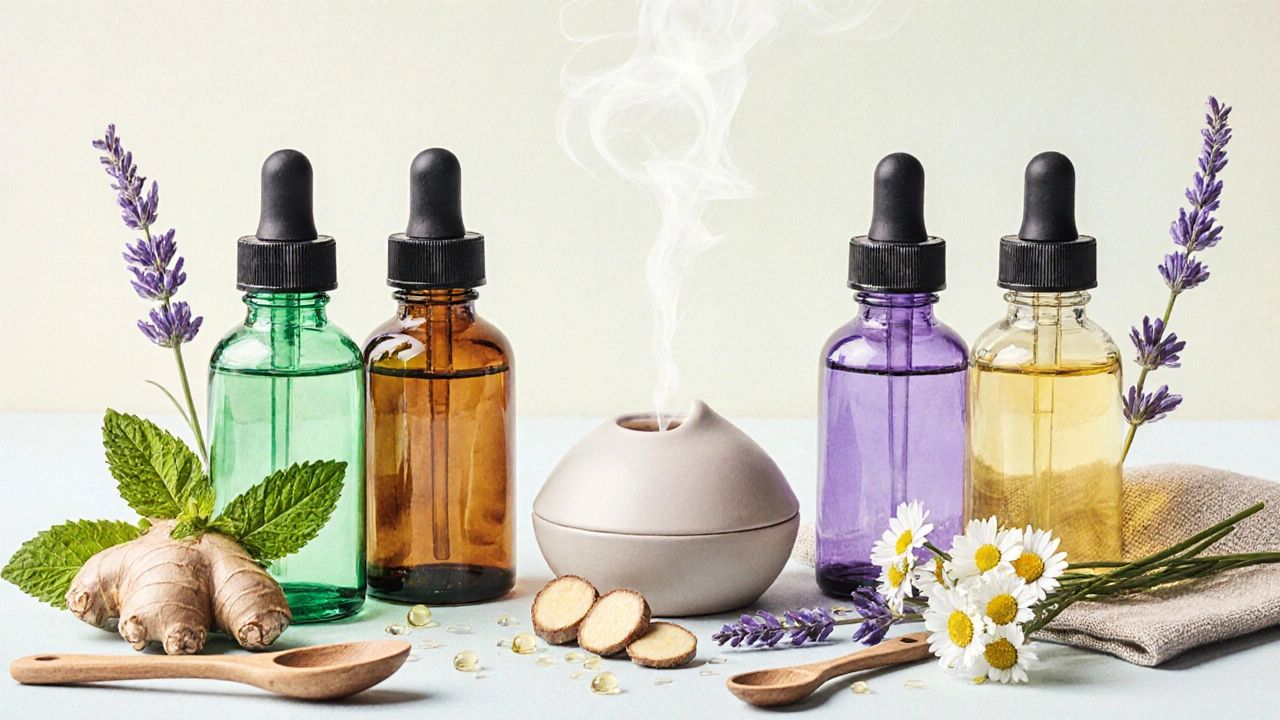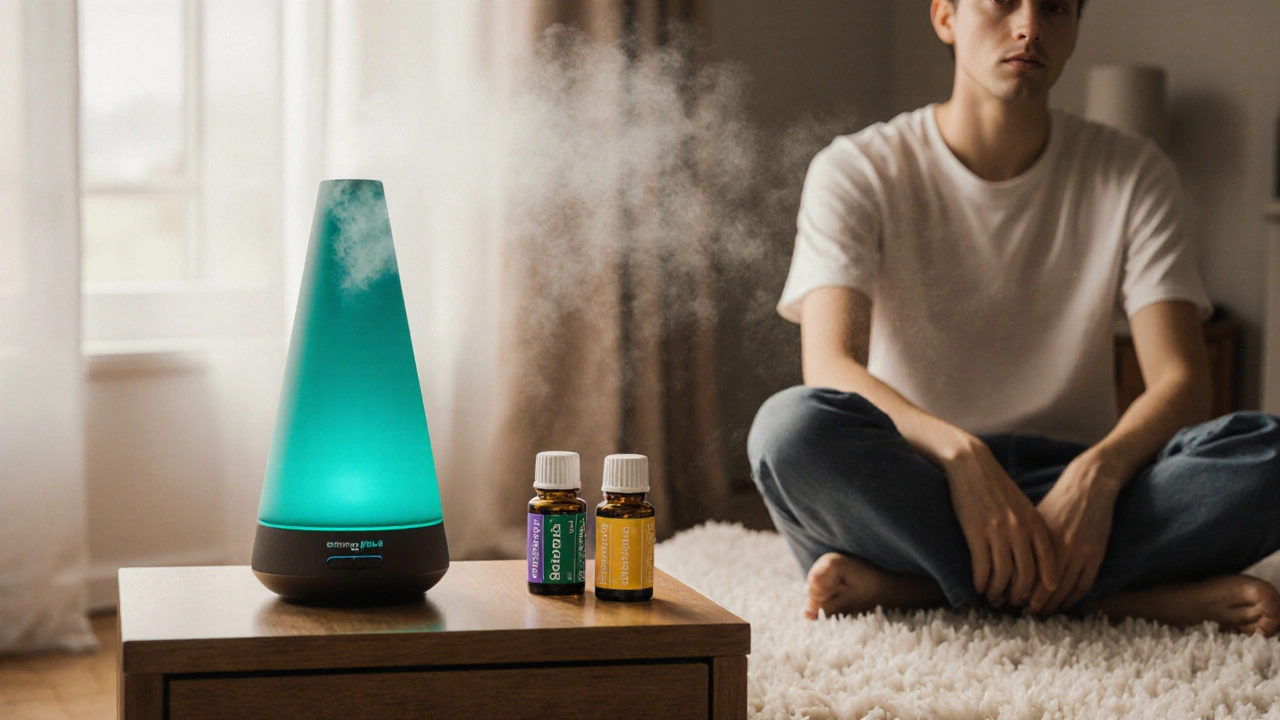Aromatherapy Dilution & Diffusion Calculator
How This Tool Works
Calculate proper dilution for topical application or diffusion times to safely use essential oils for Crohn's symptom relief. Always follow safety guidelines from the article.
Select an oil and method to see recommended dilution or diffusion times.
Key Takeaways
- Aromatherapy can lower stress, which often triggers Crohn's flare‑ups.
- Certain essential oils - peppermint, ginger, lavender, and chamomile - have documented anti‑inflammatory and antispasmodic properties.
- Safe use means proper dilution, short diffusion sessions, and awareness of individual sensitivities.
- Combining aromatherapy with standard medical care may improve quality of life without interfering with prescribed medication.
- Track symptoms before and after each oil trial to see what works best for you.
What is Aromatherapy?
Aromatherapy is a therapeutic practice that uses volatile plant extracts called essential oils to influence mood, physiology, and overall wellbeing. The oils are typically inhaled or applied topically after dilution. While the science is still evolving, dozens of clinical studies link specific oils to reduced stress hormones, lowered pain perception, and modest anti‑inflammatory effects.
Why Crohn's Disease Patients Look to Aromatherapy
Crohn's disease is a chronic inflammatory bowel condition characterized by abdominal pain, diarrhea, fatigue, and occasional fever. Triggers vary, but stress, diet, and gut‑microbiome imbalance are common culprits. Because aromatherapy can modulate the nervous system and inflammation, many patients add it to their symptom‑management toolbox.
Research in the last five years shows that people who practice regular relaxation techniques, including aromatherapy, report fewer flare‑ups and lower perceived pain scores. The mechanism is two‑fold: (1) calming the limbic system reduces cortisol spikes; (2) some oil constituents interact directly with inflammatory pathways such as NF‑κB.

Top Essential Oils for Crohn's‑Related Symptoms
Not every oil is created equal. Below is a quick‑reference table that matches the most studied oils with the Crohn's symptoms they help address.
| Oil | Key Compound | Typical Diffusion Dose (drops) | Primary Benefit for Crohn's | Possible Side Effects |
|---|---|---|---|---|
| Peppermint Oil | Menthol | 3‑5 | Reduces abdominal cramping and gas | Heartburn in high concentrations |
| Ginger Oil | Zingiberene | 4‑6 | Anti‑nausea, eases digestive inflammation | Skin irritation if not diluted |
| Lavender Oil | Linalool | 2‑4 | Calms stress‑induced flare‑ups | Rare allergic reactions |
| Chamomile Oil | Bisabolol | 2‑5 | Soothes gut lining, reduces inflammation | May interact with blood‑thinners |
How to Use Essential Oils Safely
- Choose a high‑quality, therapeutic‑grade oil. Look for clear labeling of botanical name, extraction method (steam‑distilled or cold‑pressed), and absence of synthetic additives.
- Dilute before skin contact. A standard carrier ratio is 1‑2 drops of essential oil per teaspoon (5ml) of carrier such as fractionated coconut oil or sweet almond oil.
- Start with short diffusion sessions - 5‑10 minutes, twice a day. Increase only if you notice no adverse reaction.
- Patch‑test topically: apply a tiny dab of diluted oil on the inner forearm and wait 24hours. If redness or itching occurs, discontinue that oil.
- Keep a symptom journal. Note pain levels, stool frequency, and stress moments before and after each aromatherapy session.
For most people, inhalation via a diffuser is the safest route because it avoids direct skin contact with the gut‑sensitive area.
Real‑World Stories: How Aromatherapy Made a Difference
Emma, a 29‑year‑old from Melbourne, shared that after a year of intermittent flare‑ups, she added 3 drops of peppermint oil to her diffuser each morning. Over three months, her average abdominal pain score dropped from 7/10 to 3/10, and she reported fewer urgent bathroom trips. She paired the oil with a mindfulness app, noting that the combined calming effect reduced her cortisol spikes during work stress.
Mark, 42, lives with severe ileal involvement. He experimented with ginger oil during chemotherapy‑induced nausea. Diffusing 5 drops for 10 minutes before meals lowered his nausea rating from 8/10 to 2/10, allowing him to keep up with his nutritional plan.
These anecdotes are not miracles; they illustrate how a low‑risk, adjunct therapy can complement medication and diet.

Potential Pitfalls and How to Avoid Them
Even natural substances can cause problems if misused. Here are the most common mistakes:
- Over‑diffusing. Constant exposure may lead to sensory fatigue, making the oil less effective.
- Mixing multiple strong oils without scientific backing - the combined scent can become overwhelming and may trigger headaches.
- Skipping the patch test - skin reactions are more likely with undiluted oils.
- Assuming aromatherapy replaces medication. Always keep your gastroenterologist in the loop before adding any new therapy.
When you notice any new symptom-skin rash, worsening pain, or respiratory irritation-stop the oil immediately and consult your doctor.
Integrating Aromatherapy Into a Holistic Crohn's Care Plan
Think of aromatherapy as one layer in a multi‑layered approach:
- Medical Management: Continue prescribed anti‑inflammatories, biologics, or dietary supplements.
- Nutrition: Follow a low‑FODMAP or specific carbohydrate diet as advised by your dietitian.
- Stress Reduction: Combine aromatherapy with yoga, meditation, or breathing exercises.
- Physical Activity: Light walking or swimming can improve gut motility.
- Monitoring: Use a journal or app to log flare‑up triggers and responses to each therapy.
By aligning these pieces, you create a feedback loop where reduced stress supports medication efficacy, and better gut health makes stress management easier.
Frequently Asked Questions
Can aromatherapy cure Crohn's disease?
No. Aromatherapy is an adjunct therapy that may lessen symptoms like pain, nausea, and stress. It does not replace the need for medical treatment or surgery when required.
Which essential oil is best for abdominal cramping?
Peppermint oil, thanks to its menthol content, has the strongest antispasmodic evidence. Diffuse 3‑5 drops or dilute a single drop for a brief abdominal massage.
Is it safe to use essential oils while on biologic medication?
Generally, yes, because inhalation does not enter the bloodstream in significant amounts. However, always discuss new aromatherapy practices with your gastroenterologist, especially if you use oils with known blood‑thinning effects like chamomile.
How often should I diffusing essential oils?
Start with 5‑10 minutes twice a day-once in the morning and once in the evening. Adjust based on your comfort and symptom response.
Can I use aromatherapy during a flare‑up?
Yes, but keep doses low. Strong scents may be overwhelming when you’re already feeling ill. Focus on calming oils like lavender or chamomile, and limit sessions to 5 minutes.
Next Steps: Start Your Aromatherapy Journey Today
1. Pick one oil from the table that matches your most bothersome symptom.
2. Purchase a therapeutic‑grade bottle from a reputable Australian supplier (look for ISO‑9001 certification).
3. Set up a small diffuser in your bedroom or living room. Begin with 3 drops for 5 minutes each morning.
4. Log your pain, stool frequency, and stress level for the next two weeks.
5. Review the data with your healthcare team and decide whether to keep, adjust, or try a new oil.
Remember, the goal isn’t to replace proven medication but to add a gentle, scent‑filled layer that can make daily life a little smoother. With the right oil, a consistent routine, and open communication with your doctor, many people discover a noticeable lift in comfort and mood.
aromatherapy offers a scent‑based shortcut to calm the mind and ease gut distress, but success depends on thoughtful use and realistic expectations.






Claire Willett
October 12, 2025 AT 03:06